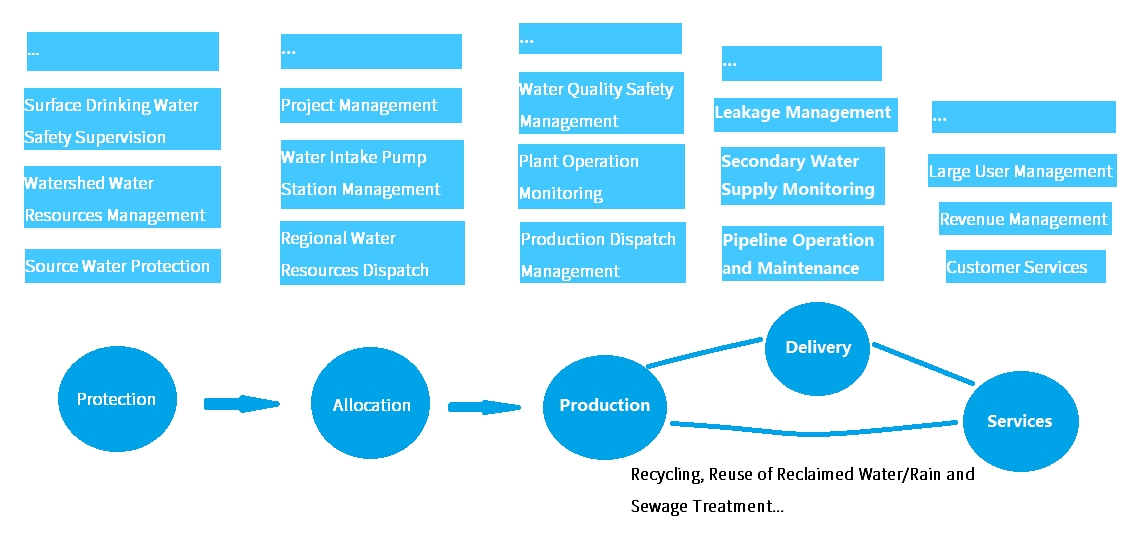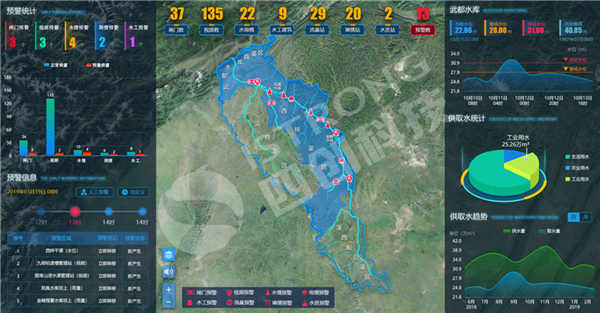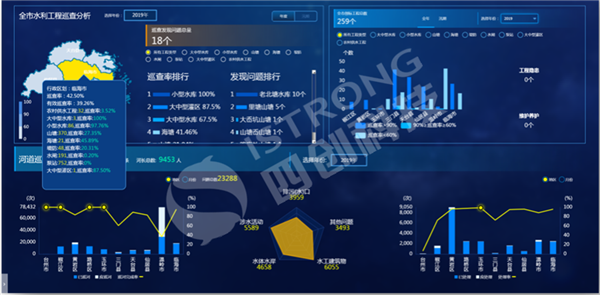
Urban and rural water supply integrated control platform
The urban and rural water supply integrated control platform provides a comprehensive management portal for local water conservancy departments, local government departments, and water supply enterprises, addressing both project supervision and long-term operation and maintenance requirements. The platform covers the entire process from water source protection to urban and rural user service water supply, thereby assisting local governments at all levels to efficiently perform their duties in collaboration with water service enterprises in the construction and operation of urban and rural water supply integration projects, highlighting performance.1、Policy background
The government proposes to vigorously promote the construction of urban and rural water supply integration, following the idea of "urban and rural integration, unified planning, state-owned control, intensive operation." This approach breaks the barriers of administrative divisions and the pattern of urban and rural water supply differentiation, integrates regional water resources, assets, and capital elements, coordinates the development of urban and rural areas, and focuses on the construction of large water sources, large water plants, and large pipe networks. By applying advanced and practical water treatment and disinfection technologies, automation control, and modern information technologies, a drinking water safety guarantee system is established from the source to the tap, comprehensively improving water supply quality and management level.
2、Solution
The urban and rural water supply integrated control platform provides a comprehensive management portal for local water conservancy departments, local government departments, and water supply enterprises, addressing both project supervision and long-term operation and maintenance requirements. The platform covers the entire process from water source protection to urban and rural user service water supply, thereby assisting local governments at all levels to efficiently perform their duties in collaboration with water service enterprises in the construction and operation of urban and rural water supply integration projects, highlighting performance.

▲Full-process Informational Services
(1) Integrated Management Portal
As the unified access point for the rural drinking water project's informational platform, it displays a comprehensive overview of water sources, water supply facilities, pipelines, drinking water projects, and monitoring points within the jurisdiction on a single map.

▲Visual Display
(2) Information Supervision Platform
✪Integrated Management Portal:
As the unified access point for the rural drinking water project's informational platform, it displays a comprehensive overview of water sources, water supply facilities, pipelines, drinking water projects, and monitoring points within the jurisdiction on a single map.
✪Water Quality Safety Management System:
Establish a full-process water quality monitoring system and a unified electronic archive of water quality testing and analysis records from the water source to the tap. Display segmented information on water source video monitoring, factory-produced water and end-of-pipeline water quality testing, as well as water quality anomaly alerts and emergency response plan settings.
✪Project Management System:
Provides standardized management functions for the entire process of urban-rural integrated water supply projects, from project application, initiation, implementation, supervision, acceptance to operation and maintenance.
✪Operational Performance Management System:
Evaluate the operational performance of each rural drinking water project's responsible entities using multi-dimensional indicators such as water supply guarantee rate, water quality compliance rate, pipeline leakage rate, and customer satisfaction. Display the results with intuitive statistical analysis charts and graphs.
✪Collaborative Office Management System:
Integrate the water supply scenario's business processes to serve the daily workflow management needs of the enterprise through an online office system. Enhance workflow efficiency by setting up remote supervision and visualized work interfaces.
✪Public Service System
With the help of new internet media such as WeChat public accounts and customer service hotlines, the latest information on the comprehensive implementation of rural drinking water safety construction is publicized to the public, water policies, water quality information and water cut-off notices are sent to the society, and public complaints and suggestions are received.
(3) Production Management Platform
✪Water Plant Automation Monitoring System
Realize remote automatic collection and monitoring of water plant production process data.
✪Pump Station Automation Monitoring System
Realize remote automatic collection and monitoring of operation data of water supply pump stations.
✪Production Dispatching Management System
Realize comprehensive scheduling and water volume allocation of water supply networks, and centralized management and instruction issuing of production data classification summary and dispatching schemes.
✪Revenue Meter Reading Management System
Including functions such as meter reading for large users, online and offline payment ports, meter reading data docking, household meter installation, water price management, and user management. By establishing a resident credit file and identifying village-level facility responsibility subjects to improve the water fee collection rate.
✪Production and Sales Difference Management System
Realize water volume evaluation and analysis of water supply networks, independent water supply and sales volume verification of each district, and visualize them with graphs, and propose measures to improve water supply loss.
✪Inspection and Maintenance System
Provide functions such as facility and equipment inspection work order circulation, on-site anomaly reporting, engineering construction management, facility operation monitoring, etc., to realize normalized maintenance of water supply network facilities and timely detection of facility operation problems, and ensure stable water supply.
3、Solution Highlights
Enhanced collaboration and performance synergy
By establishing and streamlining work processes, roles and responsibilities of construction, operation and supervision units are unified. Through sideline supervision and investigation, management issues can be identified in a timely manner. Built-in tools for schedule management and performance progress assist in self-inspection and improvement, promoting policy implementation and showcasing the government's accountability.
Enhanced application and honest supervision
Debt and overdue payment records are linked to citizen integrity records. Different functional application scenarios for towns, villages, streets and households are designed to increase system utilization. Water-saving, water conservation, and violations are included in the point system, linked with the stepped water price and welfare policies, ensuring long-term stable operation of rural drinking water systems.
Enhanced promotion and localization
Mobile application development and local self-media channels are established to increase water information dissemination rates. Short videos and other streaming media are used to promote legal and reasonable water use in rural areas. Simplifying payment, complaint, and repair procedures through microservices improves rural water service efficiency.
Enhanced decision-making and data-driven
Water network weak points are analyzed through hydraulic models, and key notes are made based on operation records, driving water network renovation and updates. Leak monitoring and water assessment in different areas drive water conservation and consumption reduction. Water demand forecasting and water quality simulation drive process improvement and scheduling optimization. Improving water supply guarantee rate and management efficiency from the perspectives of facility rationalization, scientific scheduling, and energy-saving and consumption reduction.

▲Comprehensive situational awareness control

▲Data analysis
